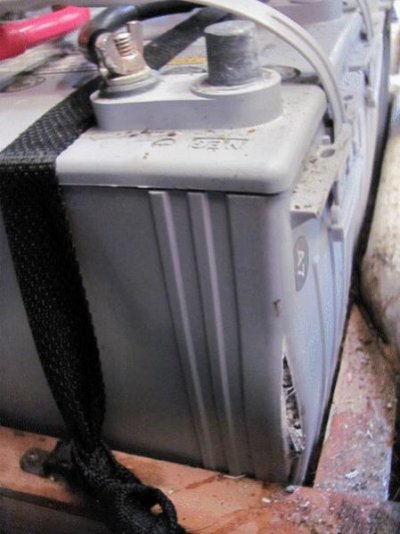You do require strapping to hold your batteries securely in place. This will prevent movement and save your connections from being forced to flex. A good, solid box designed for the size batteries you use will accomplish this easily and this is a good enough reason to put them in a box.
You are using an out of date browser. It may not display this or other websites correctly.
You should upgrade or use an alternative browser.
You should upgrade or use an alternative browser.
Battery Boxes Required?
- Thread starter bridaus
- Start date
The friendliest place on the web for anyone who enjoys boating.
If you have answers, please help by responding to the unanswered posts.
If you have answers, please help by responding to the unanswered posts.
huh, I though ABYC didn't require them for AGMs since they are "non-spillable".
Wonder where the electrolyte went from this AGM ?
Attachments
Coast Guard requires that the battery terminals are covered even when the batteries are in an isolated compartment (just big enough for two batteries), but not in boxes.
There is no such requirement in Code of Federal Regulations Title 33, Subpart 1, 183.420 which covers battery installations.
If you have found another citation I'd appreciate seeing it.
LUVYAPOP
Veteran Member
- Joined
- Jan 23, 2019
- Messages
- 43
- Location
- United States
- Vessel Name
- LUVYAPOP
- Vessel Make
- Chung Hwa Stinger custom
If I covered the terminals, strapped down the batteries properly, is there any reason to require a battery box?
Otherwise, how can you get the right size, truly make sure they are in some way water resistant (better than the battery itself) etc. etc. I feel that battery boxes are not really doing a lot for the trouble. Maybe they are a requirement?
I question the value of everything, if a battery is installed extremely well, does a battery box really offer any extra value?
I have seen very professionally strapped down batteries without boxes. So I don't think this is a dumb question....
Just a curiosity question for today.
When my boat was surveyed, the surveyor added to the "Essential Recommendations" list to have batteries in covered battery boxes. I'm fairly new to boating and owning a boat is a learning experience for me, so I wouldn't know the essential need for boxes.
I think I'm now with the "they are cheap insurance" camp. They still seem duplicative but if they protect against explosions..
How about going the next step ...... A very common recommendation in my surveys ....
ABYC "Storage Batteries" Standard E-10 and TP1332E require in part requires positive conductors be fuse protected within 7” of the battery or 40” if the conductor is fully enclosed with the exception of conductors running to engine starter motors. It is the surveyor’s opinion that this standard is inadequate and that all positive conductors should be so protected.
bridaus
Senior Member
Yes. The way I'd do it is one cable to bus bar fused at battery. Can't get that wrong. Nothing else attached to battery.
Current boat looks like an octopus stretching from the terminal. I don't like it.
Current boat looks like an octopus stretching from the terminal. I don't like it.
RT Firefly
Enigma
Greetings,
One thing that hasn't been mentioned is possible ventilation for battery boxes. Reading the "Battery Explosion" threads suggests fans, of some sort, may not be a bad idea. Perhaps small air ducts?
One thing that hasn't been mentioned is possible ventilation for battery boxes. Reading the "Battery Explosion" threads suggests fans, of some sort, may not be a bad idea. Perhaps small air ducts?
mmillerportland
Newbie
- Joined
- Aug 27, 2012
- Messages
- 1
I recently found that my 4D starting battery had literally blown apart one of the cells. I haven’t completely figured out why although I have theories, but it is clear being in a battery box saved me a lot of trouble, clean up, potential injury. There is acid and plastic bits in my battery box that could have been all over my engine compartment.
FF
Guru
- Joined
- Oct 12, 2007
- Messages
- 22,552
Folks that have no batt boxes might consider Hydro caps that convert the charging gasses back into water.
They are tall, compared to std caps. .
Hydrocap |
hydrocapcorp.com/
Recharging a lead-acid battery The electrolyte in lead-acid batteries is a dilute solution of sulfuric acid in water.Products · About Us · Contact Us · Store
They are tall, compared to std caps. .
Hydrocap |
hydrocapcorp.com/
Recharging a lead-acid battery The electrolyte in lead-acid batteries is a dilute solution of sulfuric acid in water.Products · About Us · Contact Us · Store
Similar threads
- Replies
- 29
- Views
- 2K

